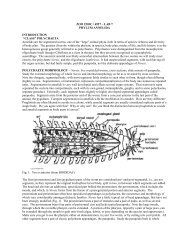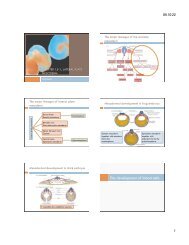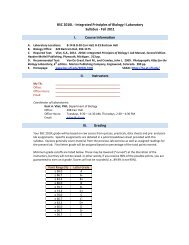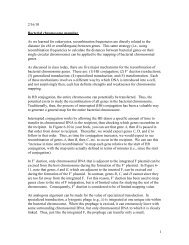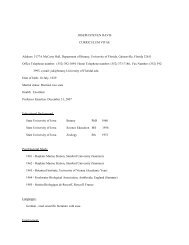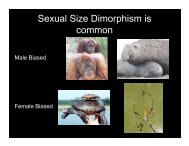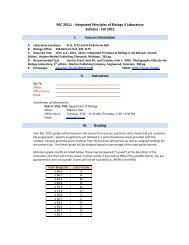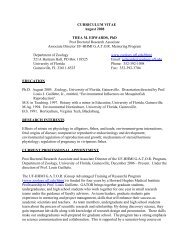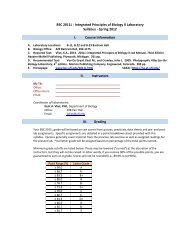Lecture Notes 7: Annelida
Lecture Notes 7: Annelida
Lecture Notes 7: Annelida
Create successful ePaper yourself
Turn your PDF publications into a flip-book with our unique Google optimized e-Paper software.
Resp.: Varied gill structures, though absent in small or narrow bugs; SA/V issues. Gills probably evolved many<br />
times. Extensions of body wall, w/ or w/o coelom, usually in association w/ parapodia, usually heavily<br />
vascularized.<br />
w/ parapodia: arenicolids - bushy, cirratulids - threads<br />
separate: terebellids - on dorsum of ant. segments.<br />
chamber: polynoids & aphroditids<br />
feeding appendages: sabellids, serpulids, spionids, etc<br />
Resp. movements - may irrigate burrows<br />
Excr.:<br />
Paired nephridia / sgm in polychaetes = segmental organs.<br />
- separate gonoduct and metanephridium – e.g. Capitellidae<br />
- separate funnels for gono- and nephr., but become confluent so one exit – e.g. Hesionidae<br />
- single main duct with nephrostome head for gametes + protonephridial head – e.g. Phyllodocidae<br />
- single funnel system serves all – most families<br />
- single funnel used for excretion; gametes exit through rupture of body wall – e.g., Nereididae<br />
Dig.: Tripartite - stomodaeum, midgut, proctodaeum.<br />
Stomodaeum may include eversible pharynx, either axial, all-around eversible, all ventral eversible pad; often w/<br />
jaws.<br />
Cuticle lining of stomodaeum can form jaws – many Eunicida and Phyllodocida<br />
Ventral, eversible pad pharynx = ventral buccal organ & ventral muscular proboscis of Rouse & Pleijel (2001) –<br />
only ventral part of pharynx everted.<br />
Axial pharynx = simple axial proboscis and muscular axial proboscis of R&P - all around eversible<br />
Midgut - ant. portion secretes dig. enzymes; undifferentiated in errants, differentiated in sedentaries into esoph., flat<br />
stomach (dig. enzymes), thinner intestine - absorption. Salivary glands may occur. Proctodaeum -- rectum, for<br />
fecal pellet fm., anus terminal, usually slightly dorsal on pygidium.<br />
Nerv.: Brain in prostomium at least in part, though may penetrate back up to 5th/6th sgm. though even then within<br />
prostomial space (septa bent to make room for it); never truly prd. as not segmental str., primitively not prd..<br />
Circumesophageal ring in peristomiumto subesophageal ganglion in peristomium + 1-5 sgm? Though some<br />
segmental ganglia may be moved up even into posterior end of brain. Ventral nerve cord prim. prd., may<br />
become fused. Single or prd. ganglia per segment (sometimes only remnants of segmentation). Giant fibers -<br />
1-5 prs. used for startle response in some sedentaries.<br />
Sens.: General sensory cells over body, esp. dorsal cirri.<br />
- Proprioceptors - respond to deformation or stress: 1) parapodial stretch receptors, 2) notopodial flap receptors, 3)<br />
dorsal cirri receptors, 4) chaetae receptors.<br />
- Statocysts in some, often w/ sandgrains, some make own lith, usually assoc. w/ ant. parapodia.<br />
- Chemoreceptors - nuchal organs - 1 pr. at line between pro- and peristomium, ciliated sensory cells (+ciliated<br />
supportive cells) covered by bizarre waxy cuticle.<br />
- Photoreceptors as simple eye spots, only 2 cell / ocellus to great alciopid eyes, which can judge distance in open<br />
water (stereoptical). Some eyes can form images. Few eyes ciliary, most rhabdomeric. Eyes on brachioles of<br />
sabellids – shadow response (w/ giant nerve)<br />
- Antennae, palps<br />
Repr.:<br />
Asexual reproduction common.<br />
- budding as clonal propagation. Syllids can have either axial or lateral budding. Dodecaceria breaks up; single<br />
segments will form whole worm – build large “colonies” really clonal aggregations with confluent tubes, but<br />
separate bodies.





